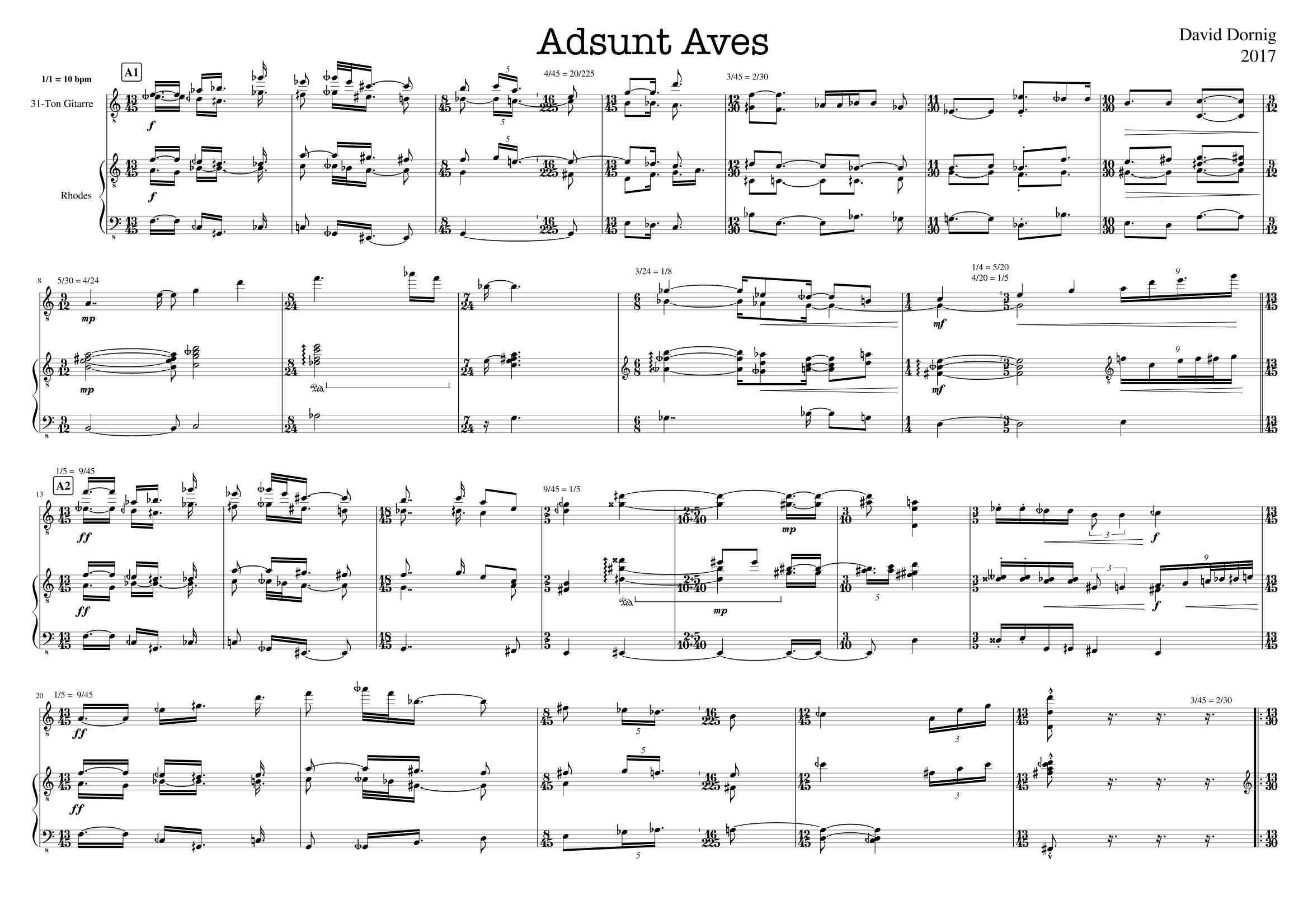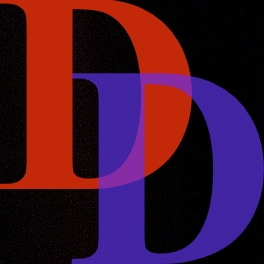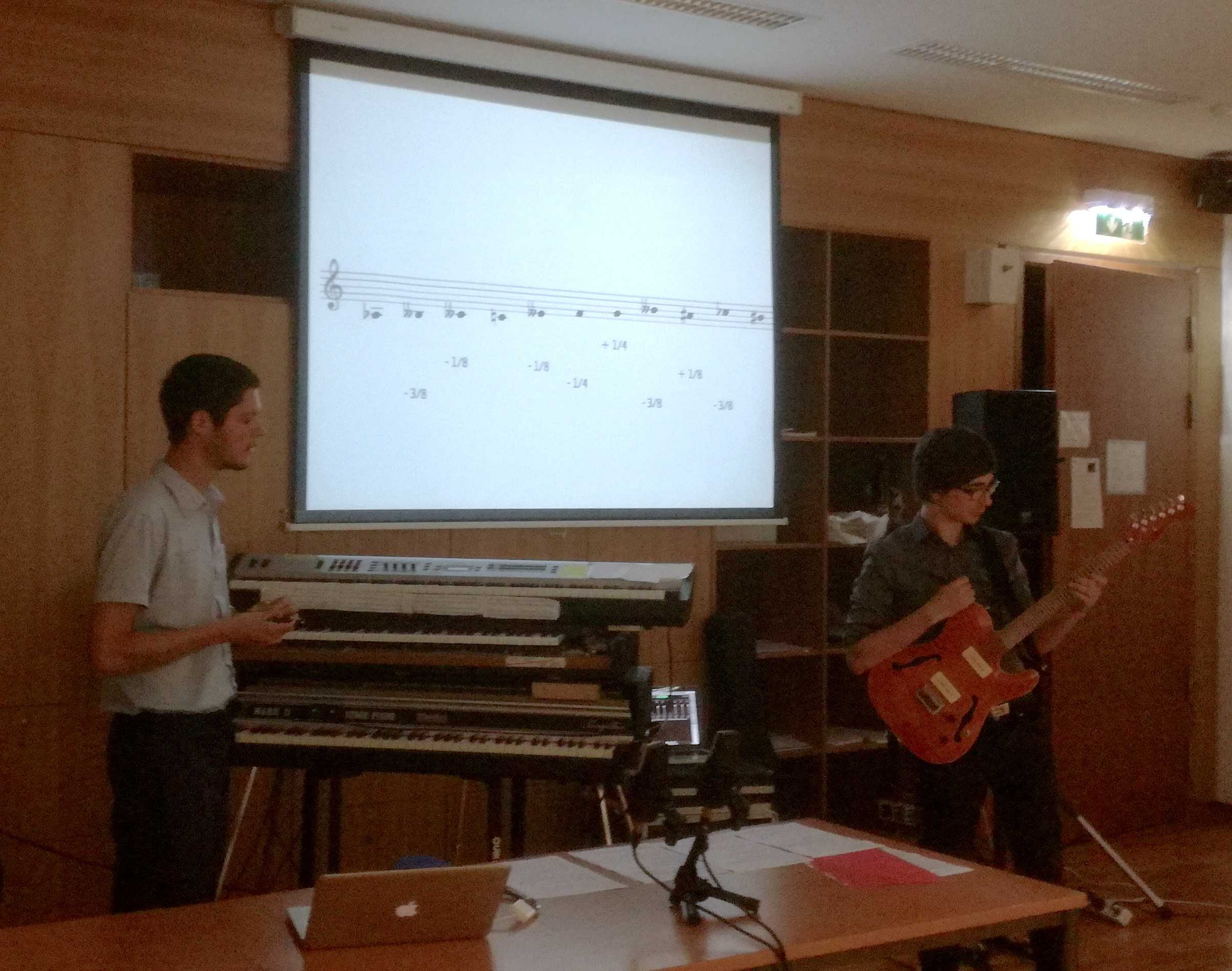Error and timbre:
The
error of a physically vibrating instrument must be considered
when
working with microtonal intervals smaller than a quarter-tone.
For
instance, the electric guitar has an error
caused
by the amplitude of the string. An
open string played fortissimo is up to 20c sharp at the beginning
of note and only within about a second reaches its target pitch.
And
even the best guitars are, of course, prone to become out of tune due
to change in humidity or temperature or during intense passages in a
piece. A deviation, which can lie anywhere between less than 1c and
10c per string.
But
how pure or “in tune” an interval sounds to the ear is also
heavily dependent on the timbre of the used instruments, as
William A. Sethares demonstrated rather impressively in his book
called Tuning, Timbre, Sepctrum, Scale, wherein he asked:
„What
is the relationship between the timbre of a sound and the
intervals, scale, or tuning in which the sound appears in tune?“
He
created an interesting comparison with an octave and a
pseudo-octave, both played with a sound of bell-like timbre.
While the real 2:1 octave was perceived as dissonant, the
pseudo-octave with the ratio 2,1:1 sounded consonant – octave like. Now,
stringed instruments are far less problematic,
but with larger intervals, like for instance a double-octave, they do
have the tendency to resonate “more
in tune” with a slightly sharp
double-octave.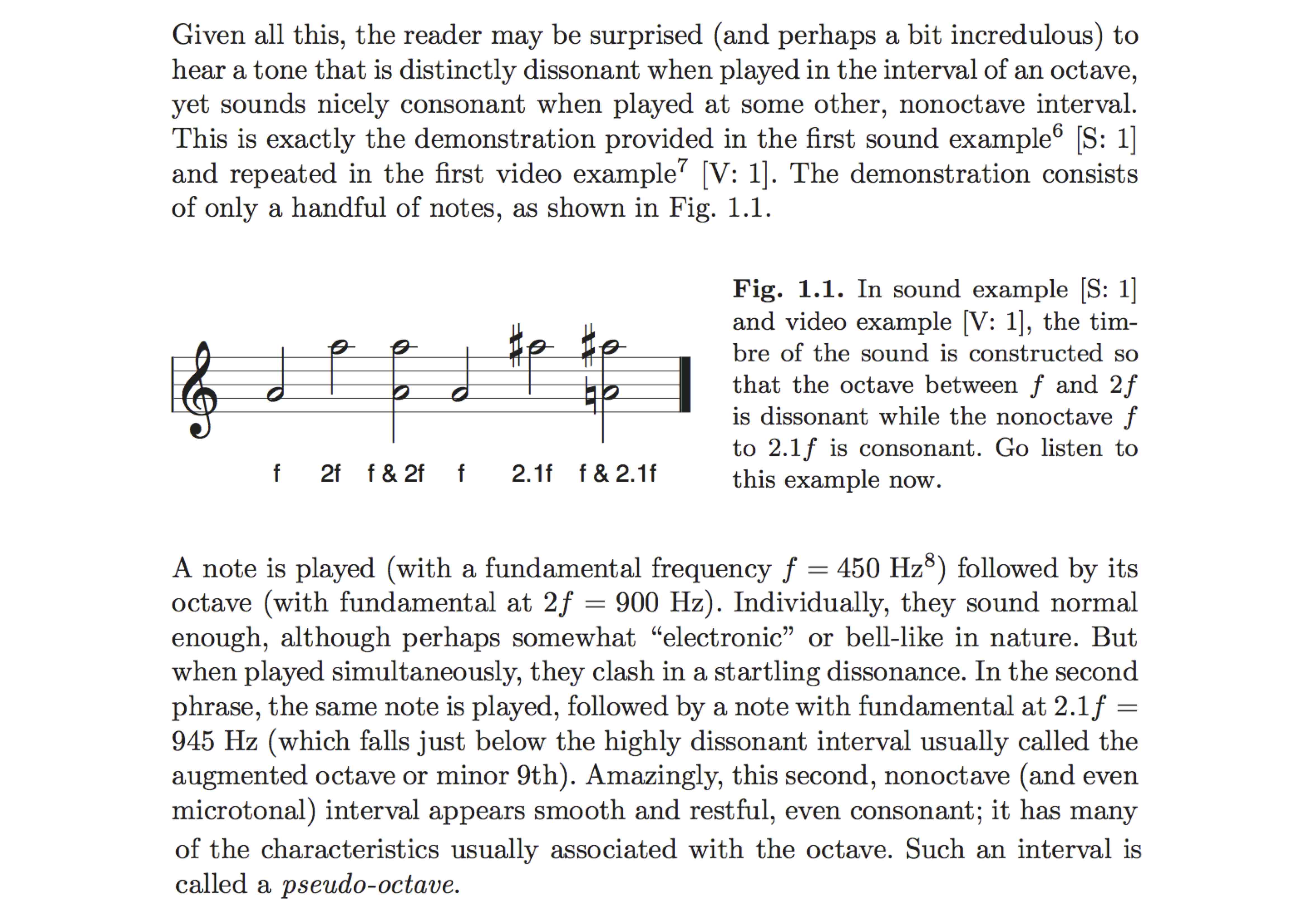
So the physical limits of tuning-stability, the relation of timbre and tuning and the octave, in which an interval resonates, have to be considered when working with real instruments or sounds with complex timbres in microtonal space.
Serialism:
Oftentimes I start composing using some kind of serialism or strict concept.This might concern the
rhythmic structure, the harmony and most often the melody. It
makes creating and, most importantly, finishing a part easier for me by narrowing down
the possibilities from unlimited to only a few, without breaking
concept. The composing-process becomes more like a puzzle-solving
experience that is about finding the most beautiful and creative
way to solve it.
Although
I'm definitely guilty of breaking concept for,
for
instance, a more musically appealing note choice, or for a more
practical guitar-fingering, that sounds just as good. The
most obvious kind of serialism that can be found in my pieces is the
use of tone-rows to create melodies and harmonic structures.
In
a recent piece of mine, I used a 31 note tone-row. In the beginning of the piece it is
vertically arranged in groups to form the chords of a ballad. After that it serves as melody and then, in its inversion, as a bass part.
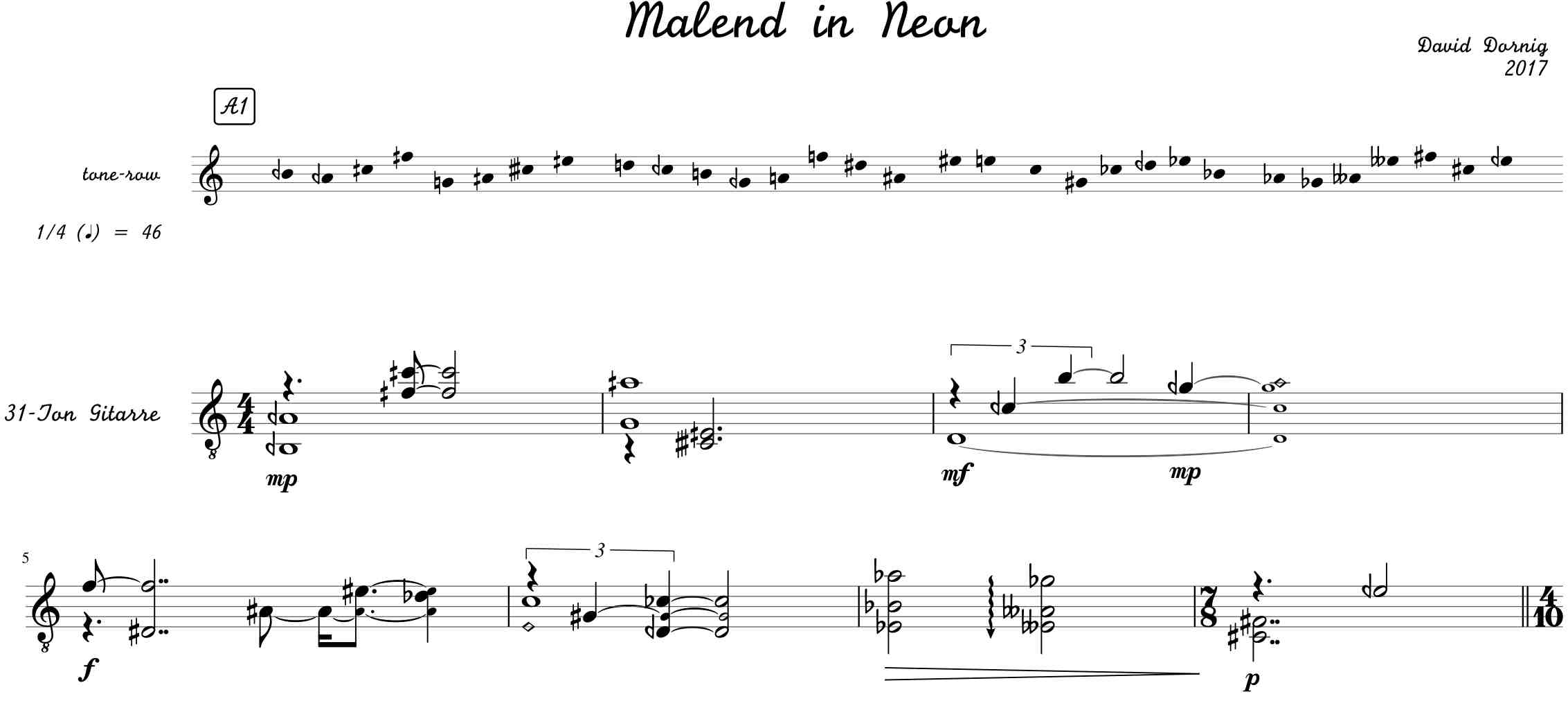
The tone-row treats the 31 notes as equally spaced pitches, with every note having the same relevance. However, the relationship between the notes of a chord, I always view as approximations of whole number ratios.
For instance the third chord of Malend in Neon:
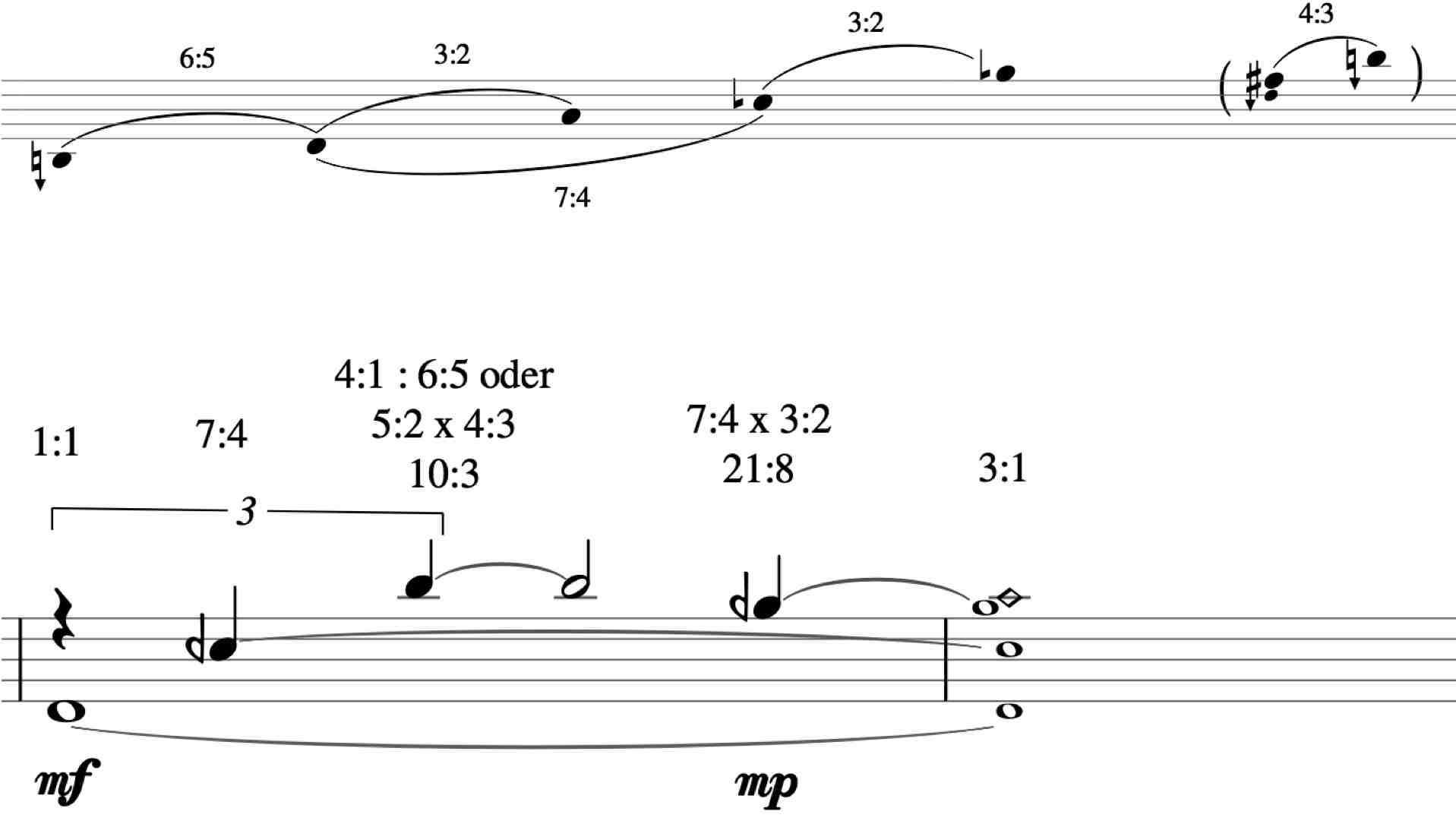
It has D as its fundamental.
7th partial – a Cd, which is almost perfectly approximated in 31-ET (with about 1c error).
Major 6th - B 10:3 - that is 8:3 * 5:4, which is the way I visualize it.
Pseudo 4th - Gd with the ratio 21:8, which is the perfect fifth (3:2) of the 7th partial. This one can be tuned justly by bending the string to pitch.
The perfect 5th of the fundamental 3:2, which is about 5c flat in 31-ET.
That way, all of our music, rhythm and harmony alike, can be expressed in whole number ratios – in some cases though, we talk about approximations.
31-ET notation:
You might have noticed the use of quarter-tone accidentals in the chart. For me it was important, that the notation represents the harmonic function a note has in my head.
So for instance, the 7th partial can be notated as an augmented 6th in 31-ET by using standard notation only. But to my ears, the 7th partial in most situations has the tonal function and feel of a rather flat minor-7th of a scale in the half-tone whole-tone-system. Therefore I started to use quarter-tone accidentals in addition to standard notation to depict notes as different intonations of a scale degree.

In this case a flat minor-7th: C half-flat to D, instead of an augmented 6th, B# to D.
Another
piece of mine called Prismaschatten uses a 7-limit 12
tone-row, which was derived from a melody I wrote that later formed
the C-Section of the piece.
The
intervals of the row are related to each other in simple
7-limit whole number ratios.
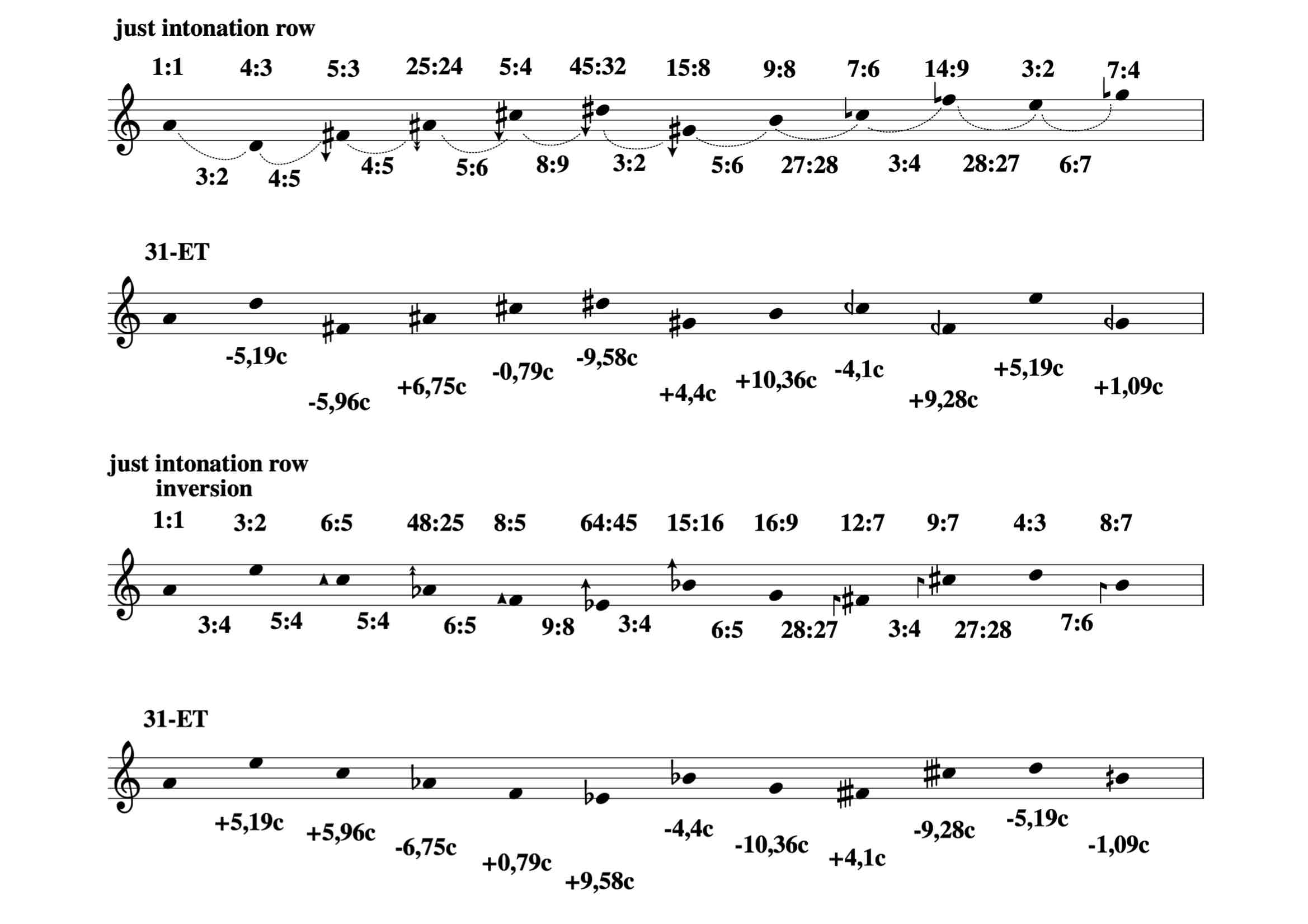
I also tried to keep the intervals rather simple in relation to the fundamental, which was the tuning note a, so they can be easily generated while practicing. The original piece was a string quartet called Schatten der Prismen, which translates to Shadow of Prisms. It was written completely in just intonation.
The
notation-system I created to write in just intonation was highly
influenced by The Extended Helmholtz-Ellis JI Pitch Notation and Ben
Johnston's way of notating just intonation. It
is based on standard notation but the
scale that can be expressed by the standard accidentals is the
endless Pythagorean scale,
which is generated by stacking perfect-fifths with the ratio 3:2. To
notate intervals based on prime-numbers other then 2 and 3, for
instance 5:4 or 11:7, additional accidentals are used, which divide
or multiply by different commas.

I liked the syntonic comma idea with the arrows attached to the enharmonic accidentals of the Helmholtz-Ellis JI Pitch Notation and also the septimal half-arrow, which somewhat looks like a seven but I couldn’t memorize the rest of them. So I used Ben Johnston's idea to use the prime numbers themselves as accidentals and made my own version that minimized, what I thought, were flaws of his notation. For instance, he inverted the numbers when the pitch was lowered. But an inverted 31 looked suspiciously like a 13. I just attached arrows to the numbers instead of inverting them, which works better in my opinion.
So I arranged the piece for our duo. We actually learned most of the piece from a chart I made with the original just-intonation notation, because I just copied, pasted and transposed from the string-quartet chart and we just looked for the closest approximation. I translated it into 31-ET notation afterwards.
It starts with the original tone-row in the keyboard-part of the Intro, followed by its inversion in A and B, which is thrown from instrument to instrument. It comes as a melody, a bass-part and even as a counterpoint. This is followed by section C with the original row as a melody.

The guitar-solo is over the original tone-row and the keyboard-solo is over the inversion of the row, like in part A. Both times it
comes as a bass-part. After the Solos there is a section where the row
and its inversion are played simultaneously, with slightly altered
intonation, to fit each others tuning. This is followed by a reprise
of part B and of the intro to wrap the piece up.
Instrument adaptation:
As
there were a lot of different pitches, adapting the piece for the keyboards required more than one keyboard and
technically rather challenging synthesizer work for Georg,
where
he uses key touch-response, in other words dynamics, to alter a pitch
by a diminished second. Also
the tremolos and glissandi, easy on stringed instrument,
became precisely notated lines with complex subdivisions, which Georg
arranged himself.
My notation:
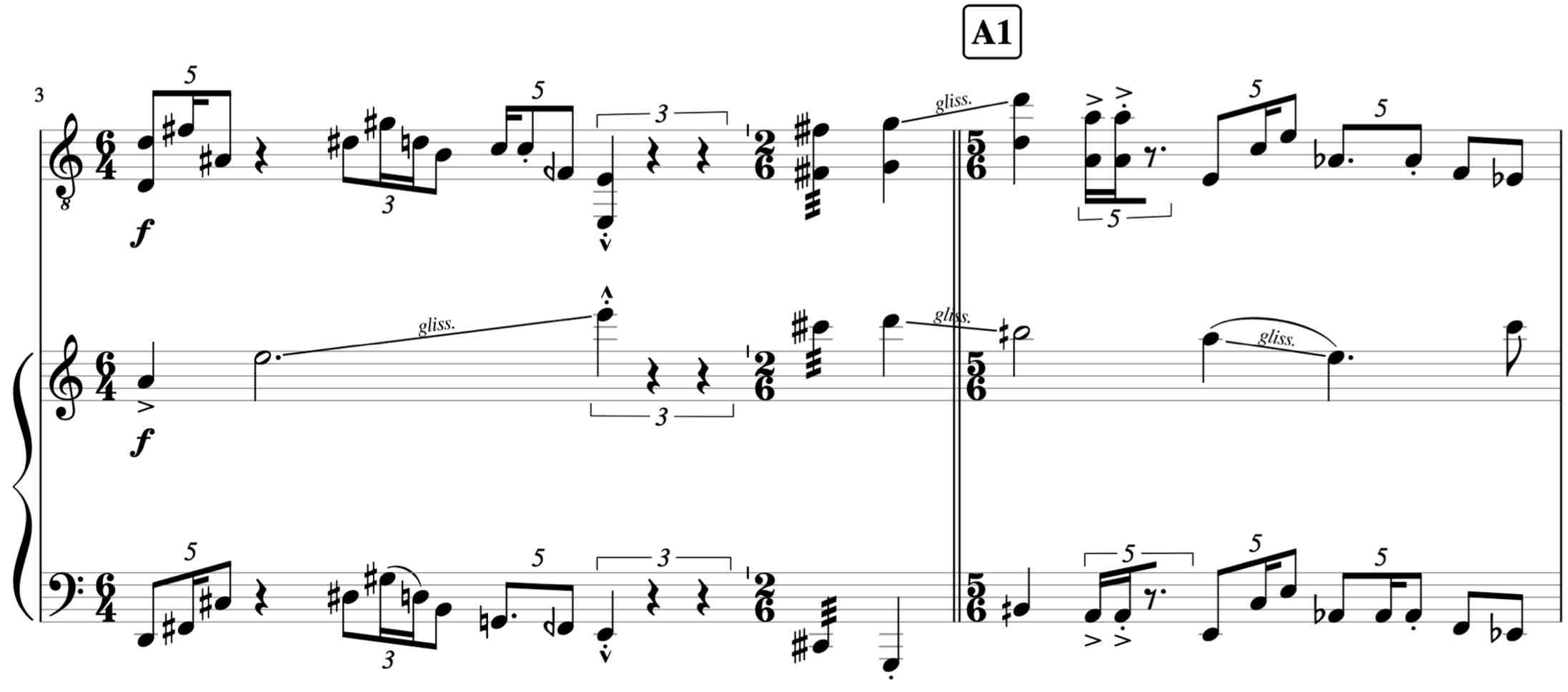
Georg Vogels interpretation:

Georg wrote a Text about making pieces of mine work on his keyboards, which can be found on his website.
The 31-tone electric guitar part was easier to adapt because it is also a stringed instrument and has all the required notes available. I took most the viola- and 2nd violin parts, which where mostly in its range, while the keyboards got the first violin and cello parts.
Now, as key-touch-response-intonation is a very time-consuming method, I tried to write a piece using only the detuned rhodes piano and guitar. This was, of course, a strict limitation concerning the available pitches and harmonies.
The piece is called Adsunt Aves – an arrangement of the German children's-song Alle Vöglein sind schon da. First I transformed the melody into a 12-tone-row. To fit the possible harmonies on the rhodes-piano, which has a fixed tuning, I took the liberty to alter every pitch by a diminished second, if necessary.
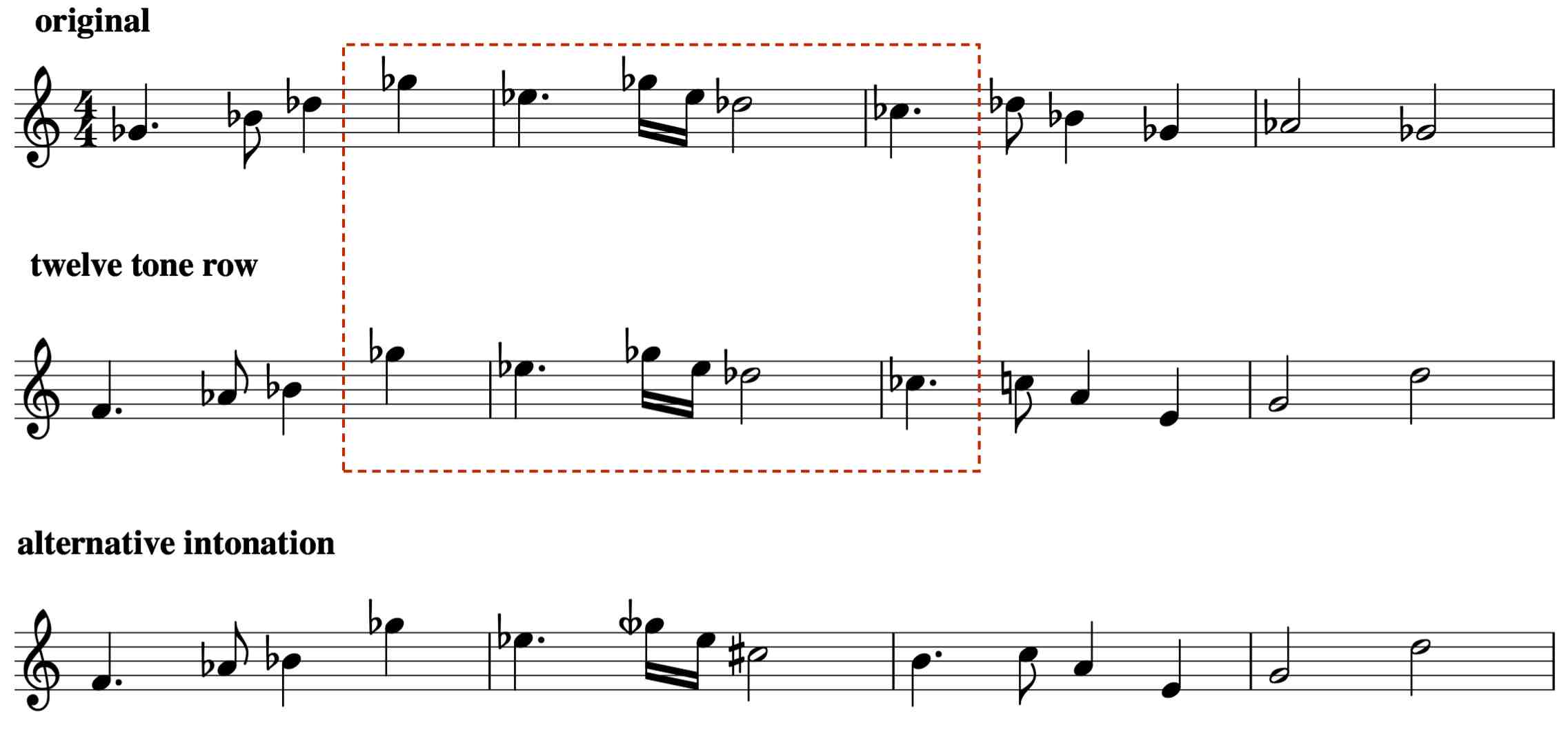
To make it more interesting rhythmically, I used the Fibonacci and Lucas sequence to morph the rhythms trough. This works great because every successive pair of numbers has a relation that converges towards phi. In other words, the proportions of the lengths of the notes stays about the same but the subdivision gets denser.
For
example the first bar in the original has four notes with 3, 1, 2 and
2 beats value, in this case: 8th notes. If we morph this
through the Fibonacci sequence and go one step higher, then 3 becomes 5, 1
becomes 2 and 2 becomes 3.
In
the second bar, I used the Lucas-numbers: so 3 becomes 4, 1 becomes 2
and 4 becomes 7. 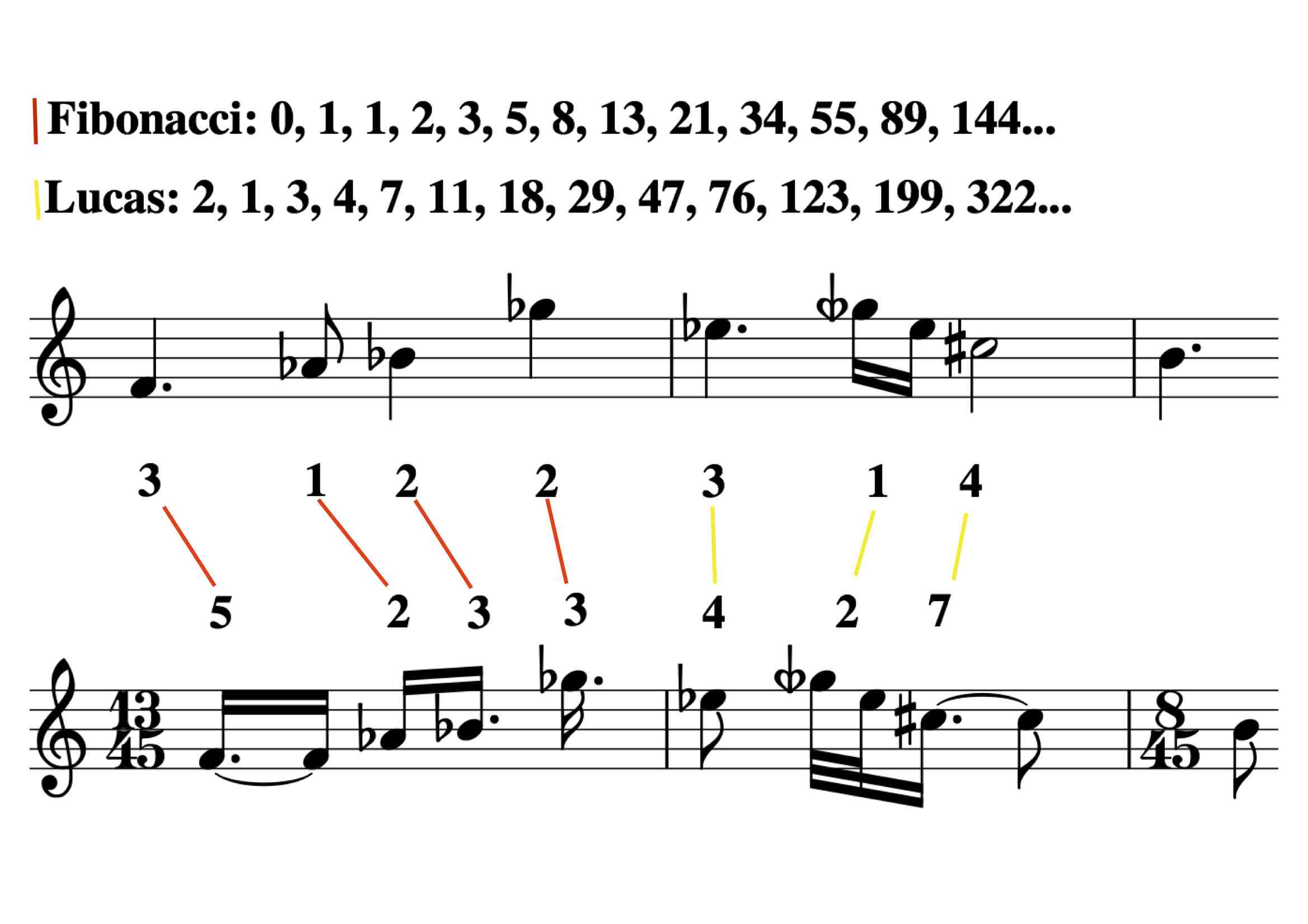
I also used rhythmical modulations to have a wide
pallet of different tempos. This can be found in almost all of the pieces in Dsiltons repertoire. For instance in the first version of the melody, it
modulates gradually from very fast to very slow and then back at once
into the original tempo from the beginning for the 2nd
version of the melody.
I
also used consecutive numerators in the time signatures. They start
at the 4th bar: 13,12, 11, 10, 9, 8, 7, 6... This makes the composing-process a fun
challenge.
